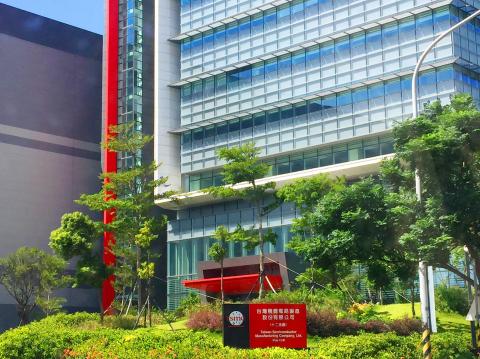Taiwan Semiconductor Manufacturing Co (TSMC, 台積電), the world’s biggest contract chipmaker and sole chip supplier for Apple Inc’s iPhones, yesterday said that it is building a new 8-inch fab to meet robust demand for mature technologies, marking its first investment on a less advanced fab in 15 years.
Supply of mature and specialty technologies, especially from 8-inch fabs, has been constrained industrywide over the past year as demand rises for power management ICs, fingerprint identification chips, complementary metal-oxide-semiconductor (CMOS) image sensors and a wide range of other applications.
Tight supply caused a rare price hike for 8-inch wafers earlier this year.

Photo: Hung Yu-fang, Taipei Times
Beyond investment on scaling down chip sizes, “we also spend on specialty technologies,” TSMC vice chairman and chief executive officer C. C. Wei (魏哲家) said in his opening speech at the company’s annual supply chain management forum in Hsinchu. “Most recently, we are building a new 8-inch fab in Tainan because demand is so strong.”
The company is working closely with customers so that it can build capacity in advance to satisfy their demand, Wei said, implying that customer demand for less advanced chips has remained unscathed amid a fickle global trade environment.
TSMC offers a wide range of specialty technologies from power management ICs and CMOS sensors to microelectromechanical systems.
The new 8-inch fab, TSMC’s fifth, would be adjacent to an existing 8-inch fab, Fab 6, TSMC said.
In October, TSMC said that factory utilization at its 8-inch fabs was good and customers were lining up for certain mature technologies.
Demand for 8-inch wafers remained strong and no signs pointed at a slowdown, the chipmaker said that month.
Local rival United Microelectronics Co (UMC, 聯電) in October also reported strong demand as it told investors that its 8-inch fabs would be fully loaded this quarter.
UMC plans to add 2 percent more 8-inch wafer capacity this year to increase supply.
TSMC plans to spend US$10 billion to US$10.5 billion on new equipment this year, mostly to increase production of its most advanced 7-nanometer technology.
The company plans to keep its capital spending high at between US$10 billion and US$12 billion in next five years to maintain its technological leadership and to support its revenue growth target of 5 percent to 10 percent annually, it said.
With heavy investment on advanced technologies, the chipmaker expects to begin risk production of next-generation 5-nanometer technology in the second quarter of next year and to enter mass production in 2020, Wei said.
The company is also preparing to start building a new fab for 3-nanometer technology, he said, adding that the construction plans are subject to an environmental impact assessment.
Separately, TSMC yesterday dismissed a report by the Nikkei Asian Review, saying that it is not launching any austerity program or cutting employees’ overseas travel in response to flagging customer demand.
The chipmaker said it downgraded a car leasing program for the company’s high-ranking executives in March.
Vice presidents of TSMC were told to choose affordable Toyota cars to commute, instead of luxury Mercedes or BMW models, the chipmaker said, adding that they could still opt for luxury cars by paying the difference.

PATENTS: MediaTek Inc said it would not comment on ongoing legal cases, but does not expect the legal action by Huawei to affect its business operations Smartphone integrated chips designer MediaTek Inc (聯發科) on Friday said that a lawsuit filed by Chinese smartphone brand Huawei Technologies Co (華為) over alleged patent infringements would have little impact on its operations. In an announcement posted on the Taiwan Stock Exchange, MediaTek said that it would not comment on an ongoing legal case. However, the company said that Huawei’s legal action would have little impact on its operations. MediaTek’s statement came after China-based PRIP Research said on Thursday that Huawei filed a lawsuit with a Chinese district court claiming that MediaTek infringed on its patents. The infringement mentioned in the lawsuit likely involved

Taipei is today suspending work, classes and its US$2.4 trillion stock market as Typhoon Gaemi approaches Taiwan with strong winds and heavy rain. The nation is not conducting securities, currency or fixed income trading, statements from its stock and currency exchanges said. Authorities had yesterday issued a warning that the storm could affect people on land and canceled some ship crossings and domestic flights. Taiwan Semiconductor Manufacturing Co (TSMC, 台積電) expects its local chipmaking fabs to maintain normal production, the company said in an e-mailed statement. The main chipmaker for Apple Inc and Nvidia Corp said it has activated routine typhoon alert

GROWTH: TSMC increased its projected revenue growth for this year to more than 25 percent, citing stronger-than-expected demand for AI devices and smartphones The Taiwan Institute of Economic Research (TIER, 台灣經濟研究院) yesterday raised its forecast for Taiwan’s GDP growth this year from 3.29 percent to 3.85 percent, as exports and private investment recovered faster than it predicted three months ago. The Taipei-based think tank also expects that Taiwan would see a 8.19 percent increase in exports this year, better than the 7.55 percent it projected in April, as US technology giants spent more money on artificial intelligence (AI) infrastructure and development. “There will be more AI servers going forward, but it remains to be seen if the momentum would extend to personal computers, smartphones and

Catastrophic computer outages caused by a software update from one company have once again exposed the dangers of global technological dependence on a handful of players, experts said on Friday. A flawed update sent out by the little-known security firm CrowdStrike Holdings Inc brought airlines, TV stations and myriad other aspects of daily life to a standstill. The outages affected companies or individuals that use CrowdStrike on the Microsoft Inc’s Windows platform. When they applied the update, the incompatible software crashed computers into a frozen state known as the “blue screen of death.” “Today CrowdStrike has become a household name, but not in